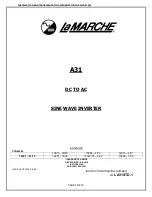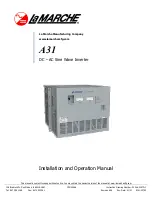
MS-SOUND-decoders MS440 to MS990 Page 53
Diesel and Electric engines have certain commonalities and are therefore described in the same chap-
ter: Diesel-electric propulsion systems have sound components (sound sequences) from both areas.
On the other hand, the separation of "Basic settings" and "Load dependence" (as with the steam en-
gines in the previous chapters) is not practical.
CV
Denomination
Value-
Range
INC
step
De-
fault Description
#266
Total volume
0 - 255
5
64
See chapter “Basic settings independent of
powertrain”
#280
Diesel engine
-
Load dependency
in
SW version 5.00 and
higher
0 - 255
10
With this setting, the diesel motor’s reaction to the
load (defined by PWM and speed step). Note: the
sound of the diesel motor practically always de-
pends on acceleration and speed.
Diesel-hydraulic loco - higher and lower PWM
and performance steps,
Diesel-electric loco - driving/idle loco with
switchgear - steps.
= 0: no influence Motor PWM according to speed
= 1 to 255: increasing to maximum influence
NOTE: It is recommended, first to perform the
automated test run
with CV #302 = 75 first (see
chapter 5.3).
#154
Various special bits
-
Bit 1 = 1: (DIESEL) Drive off immediately even if
playback of idle sound has not yet finished.
Bit 2 = 1: DIESEL, ELECTRO After short stops,
wait for idle sound before driving off.
Bit 4 = 1, bit 7 = 1: see STEAM.
#158
Bit 1
SW version 5.00 and
higher (only
diesel mechanical)
Various special bits
(mostly in connection
with functions defined
in various other CVs)
Bit 1 = 1: Diesel mechanical: RPM is not raised
when braking (see CV #364).
Bit 2 = 0: RailCom speed feedback (km/h)
feedback in “old” format (for
MX31ZL, RailCom ID 4)
= 1: RailCom speed feedback (km/h)
Normal feedback (RailCom ID 7)
Bit 3 = 1: “Looped” driving sounds (i.e. idle sound)
will be faded out when switching to a
different speed step in order to shorten
the sounds.
Bit 4 = 1: Steam chuff frequency increases slower
at high speed (non-proportional)
Bit 5 = 1: Braking (even by one speed step)
causes the motor and turbo charger
sound to pitch down one sound step
.
#344
Run time of
motor sounds
(Cooling fan, etc.)
after stops
0 - 255
=
0 - 25 sec
-
After the engine comes to a stop, some accesso-
ries are supposed to remain operating (e.g. cool-
ing fans) and automatically stop after the time de-
fined here, provided the engine didn’t start up
again.
= 0: Won’t run after stop
= 1 - 255: Runs for another 1 to 25 seconds.
#345
Switch key
to next sound
variation within a sound
collection
for different operating
modes of a locomotive
or
between the sounds of
a multi-system engine
1 – 28
Defines a function key (F1 – F28) which switches
between two sound types that is, between the se-
lected sound in CV #265 and the next one in the
list. For example:
- Switch between two modes of operation (light
train / heavy train) or
- Switch between electric and diesel propulsion of
a multi-system engine; typical case:
Sound project for RhB Gem.
#346
Conditions for switch-
ing between
collections, as per CV
#345
0, 1, 2
0
Bit 0 = 1: Switches also at stand-still,
Bit 1 = 1: Switches also while cruising (bits for
standstill and cruising possible at the same
time)
Bit 6 = 1: Transition sets in diesel projects, which
are played back when switching from one set to
another.
#835 Further switching keys
0 - 32
Extension to CV #345. Here the number of con-
secutive keys can be defined, which then switch
to auf Set2, Set3, Set4, …. .. Then first key is still
defined in CV #345.
#347
Switch key
to switch key for driving
and sound perfor-
mance
when driving solo
0 - 28
= 0: No key, no switch possible.
= 1 - 28: One of these function keys (F1 – F28)
acts as the switch-over key for driving a heavy
train or a single locomotive. Parameters are se-
lected with CV #348.
#348
Selection of
measures to be taken
when switching to
solo drive (with key se-
lected in CV #347)
0 - 31
When driving solo (function key as per CV #347 is
ON), …
Bit 0 = 1: ... Diesel sound (sound steps)
shall rise unlimitedly at acceleration
(otherwise limited by CV #389 dependent
of speed step).
Bit 1 = 1: ... acceleration and deceleration
times should be reduced according to
CV#3 #4 but consider the range of
reduction defined in CV #390.
Bit 2 = 1: ...driving at low-speed ranges with
stationary noise possible, whereby the
highest speed step with stationary noise
is defined in CV #391.
Bit 3 = 1: 2nd smoke fan and heater deactivated
with loco driving key (two-motor diesel
loco only drives with one).
2
nd
smoke fan and heating deactivated
on the higher output each if this key is
ON
Bit 4 = 1: Brake squeal is suppressed with
loco driving key.
















































